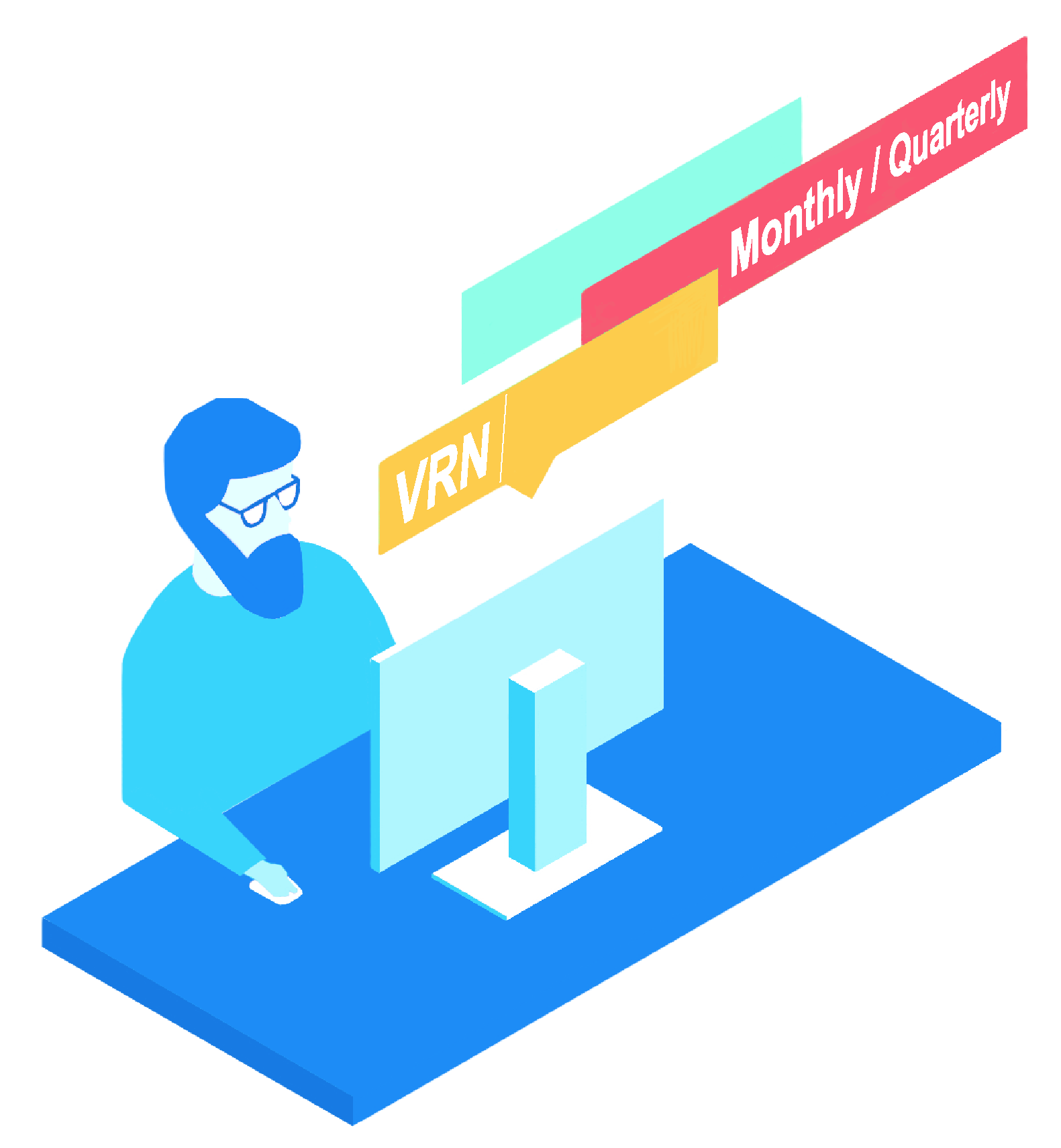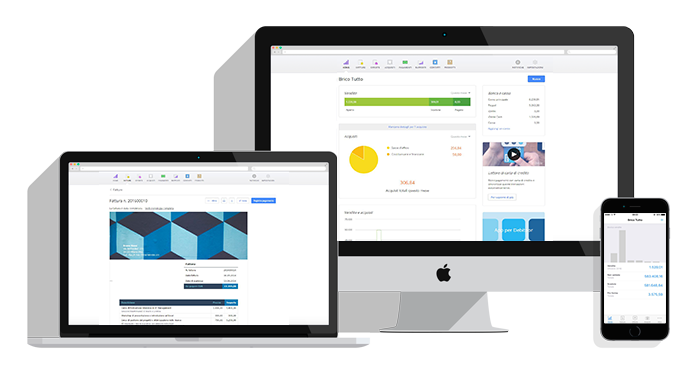Easy VAT returns for small businesses with Making Tax Digital software
Manage and report your VAT directly to HMRC with Making Tax Digital software

Making Tax Digital in 7 questions
To comply with the requirements under Making Tax Digital, HMRC has stated that approved software must be used by businesses to submit VAT returns.
Learn more about the impacts of MTD, whether it applies to your business, and how Debitoor can make it easy for you to record and manage your VAT and submit your VAT returns online.
Question 1: Making Tax Digital – why, how, when?
In the UK, HMRC announced plans to move towards a more digital system. So what is Making Tax Digital? The aim was to introduce a system that helped businesses submit VAT returns faster, more efficiently, and with fewer errors. After the process faced some delays, the important deadlines were finally set:
April 1st, 2019
The first deadline. This deadline states that all UK businesses that have annual taxable turnover above the VAT registration threshold of £85,000 must use approved Making Tax Digital software in order to submit their VAT returns online, directly to HMRC.April 1st, 2020
The second deadline. By the following year, all businesses that are VAT registered (including those voluntarily registered) with a taxable turnover above £10,000 must use approved software to submit VAT returns online. This means that these businesses will need to find and begin using Making Tax Digital compliant software by the above dates unless they are a complex business eligibile for the delayed start date.Question 2: Who needs to use Making Tax Digital compliant software?
In the UK, any business that exceeds a taxable turnover of £85,000 is required to register for VAT. However, it is also possible to register for VAT voluntarily if you wish to be able to charge VAT and claim back VAT on purchases.
The move to Making Tax Digital backs HMRC's goal to become one of the most digitally advanced tax systems in the world. The intention is therefore that eventually, all tax returns will be submitted digitally. This is being rolled out in stages, first applicable to businesses above the VAT threshold, then applying to businesses with lower turnover the following year.
There are two reasons that a businesses could be excluded from the requirement to submit VAT returns digitally:
1. If your business has internet restrictions. This can be due to access issues caused by a remote location, to age, to disability, or to religion.
2. If the business falls below the minimum threshold. For businesses that have an annual taxable turnover that totals less than £10,000, it is not necessary to submit VAT returns online under Making Tax Digital.
Question 3: How is VAT calculated in Making Tax Digital software?
There are two options for submitting VAT returns online to HMRC. The first is using Making Tax Digital compliant software like Debitoor to record, manage, and submit your VAT. The second is to continue keeping records offline in spreadsheets and using bridging software to submit your VAT returns.
Always the right rate
If your business is VAT-registered, you must charge VAT on invoices, typically at 20% unless your product or service falls under a lower VAT rate of 5% or zero-rated. You will also be charged VAT by suppliers and can claim back a certain amount.
With Making Tax Digital software, you can record your expenses from anywhere with mobile apps, enter payments on invoices as you go, and more. When you have VAT activated in your account, the VAT from the data you input is automatically calculated when you click to generate your VAT report.
Adding your receipts
Even the self-employed have expenses when running a business. An inevitable and arguably important part of a business, expenses can be regular costs or one-off. In any case, you'll likely be issued a receipt or invoice. It's important to record and keep track of these expenses. This can be done by simply taking a picture of the receipt with your smartphone or uploading the invoice. VAT amounts are automatically added to the calculations for the return for that period.
Question 4: How often do I have to submit my VAT returns online to HMRC?
According to HMRC, most small businesses should submit VAT returns quarterly. However, it is also possible to submit monthly returns. Making Tax Digital will follow the same tax periods as previously.
Quarterly VAT returns
As the standard reporting period, the majority of self-employed and small businesses registered for VAT submit quarterly returns. Quarterly returns are useful for businesses who prefer to deal with VAT more frequently - that it can be paid and claimed for each quarter. If you are VAT registered, your returns schedule will fall under one of three quarterly staggered periods for return dates:
When you registered for VAT, you would have been assigned one of these staggered periods for your quarterly returns. Both quarterly and monthly VAT returns should be submitted by the 7th of the month after the end of each period.
Monthly VAT returns
Depending on your business, you can request to submit returns monthly rather than quarterly. This can be a good option for businesses on the Annual Accounting Scheme or if they are considered a regular repayment trader (exporter). On the Annual Accounting Scheme, payments are expected in advance throughout the year but only one return is submitted annually. If you prefer monthly payments, you will need to first get permission from HMRC.
Question 5: Can I submit my VAT return online if I'm below the threshold?
Yes. If your business is currently VAT registered and you have a VRN but are not currently over the £85,000 threshold, you can choose to begin using Making Tax Digital software to submit your VAT returns online to HMRC.
If you're currently VAT registered but your annual business turnover is under the minimum threshold, or if you have received a delay due to being considered a complex business it is not necessary to begin using Making Tax Digital software to submit VAT returns online as of April 1st, 2019.
If you're not currently VAT registered, or if your business falls under the minimum threshold of £10,000 taxable turnover, you cannot submit VAT returns online to HMRC. However, you can still use online software to create, send, and manage your invoices and expenses.
Question 6: What happens after I submit my VAT return online?
If you're using Making Tax Digital compliant software like Debitoor, the process of submitting your VAT returns online requires a quick setup the first time, and after that can be done with just a few clicks. When you submit a VAT return to HMRC you must confirm that the information you are submitting is true and complete.
After you've submitted your VAT return from your Making Tax Digital software, you should receive a receipt confirming that the submission of your VAT information was successful and also containing details about the VAT return for that period. You will also be able to make payments online to HMRC.
Within your MTD software, you should then be able to see that the VAT return for that period has been submitted and view the details of the return.
Question 7: Are there penalties for late filing of VAT returns?
Like submitting a VAT return late by post, there are also penalties if a return is submitted after the VAT return deadline. Your deadline might differ depending on your reporting period, but the VAT return due date is 7 days into the month following the end of each reporting period. In the MTD 'soft landing' period, the current penalty system will apply.
However, HMRC has reformed the penalty system for MTD beginning April 2020. It will be points-based; with points added for each late submission of VAT returns. Once a certain number of points is reached, the business faces a late VAT return penalty fee.
For quarterly VAT submission, this has been quoted at 4 points. Late monthly submissions will have a point threshold of 5 points, and annual accounting just 2 points before the fee is incurred. However, it is possible to get rid of points (a deduction of 1 point for each VAT return submitted on-time). Points are said to expire after a period of 24 months and it is also possible for businesses to appeal the issuing of points.
Debitoor x Making Tax Digital
As Making Tax Digital-compliant software, it's easy to connect your Debitoor account to HMRC to allow for fast, easy submission of your VAT returns online.
With a Debitoor account, you can:
Debitoor offers Making Tax Digital free software that will be available with a subscription to an M or L plan.
Get Making Tax Digital software now

MTD and accounting software
Debitoor offers a full range of invoicing & accounting features, designed with sole traders, freelancers, and small businesses in mind.
Create, send, and manage invoices from anywhere and be notified the moment your invoice is viewed.
Register expenses with a snap from your smartphone or upload to your computer. Your account is always up-to-date with instant syncing across devices.

